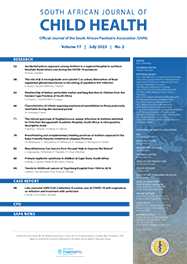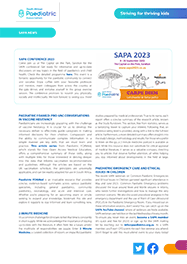Articles

Incorrectly diagnosing children as HIV-infected: Experiences from a large paediatric antiretroviral therapy site in South Africa
Abstract
Methods. This was a retrospective patient record review of all ART-naïve children referred to Kalafong hospital’s paediatric HIV clinic between April 2004 and March 2010, with detailed review of those found to be HIV-uninfected.
Results. There were 1 526 patient files analysed, with a male-to-female ratio of 1.01:1 and median age at first visit of 20 months (range 26 days - 17.5 years). Nearly half (n=715; 47%) of the children were aged <18 months. Fifty-one children were found to be HIV-uninfected after repeated diagnostic tests. Incorrect laboratory results for children aged <18 months included false-positive HIV DNA PCR tests (40), detectable HIV viral loads (4) and a false-positive HIV p24Ag test (1). One child above 18 months had false-positive HIV ELISA results. An additional 4 children were inappropriately referred after being incorrectly labelled as HIV-infected and 1 child aged <18 months was referred after an inappropriate diagnostic test for age was used. In summary, 1 in every 30 (3.3%) children was discharged HIV-uninfected, and below age 18 months, 1 in 16 children (6.3%) had false-positive HIV virological tests.
Conclusions. Urgency in ART initiation in HIV-infected children is life-saving, especially in infants. However, HIV tests may produce false-positive results leading to misdiagnosis of children as HIV-infected, which has serious consequences. Meticulous checking of HIV-positive status is of utmost importance before committing any child to lifelong ART.
Authors' affiliations
Ute Dagmar Feucht, Department of Paediatrics, Kalafong Hospital, University of Pretoria, Pretoria
Winifred Nancy Thomas, Department of Paediatrics, Kalafong hospital, Pretoria
Brian William Cameron Forsyth, Department of Pediatrics, Yale University, New Haven, CT
Mariana Kruger, Department of Paediatrics and Child Health, Stellenbosch University, Tygerberg
Keywords
Cite this article
Article History
Date published: 2012-08-23
Article Views
Full text views: 6291

.jpg)



Comments on this article
*Read our policy for posting comments here